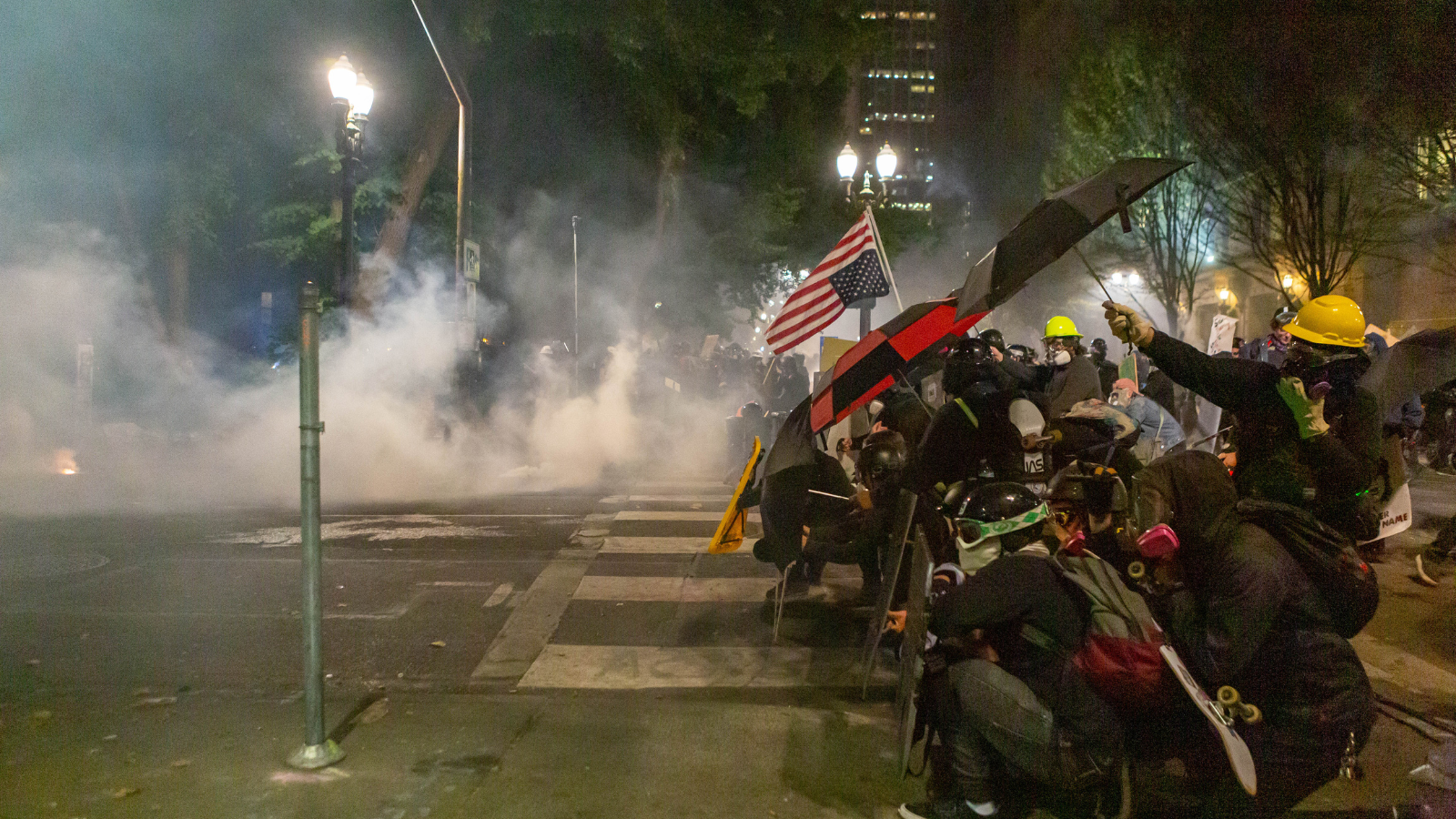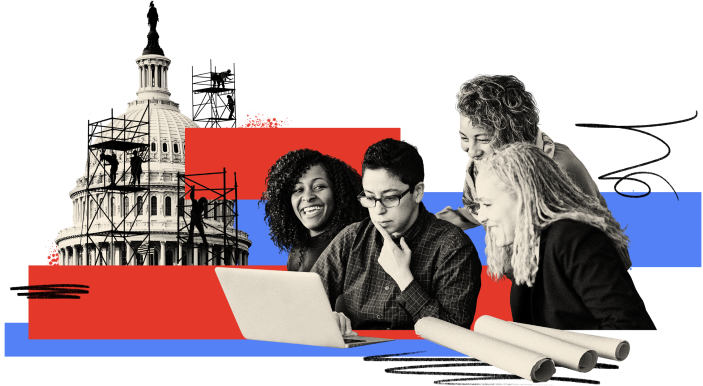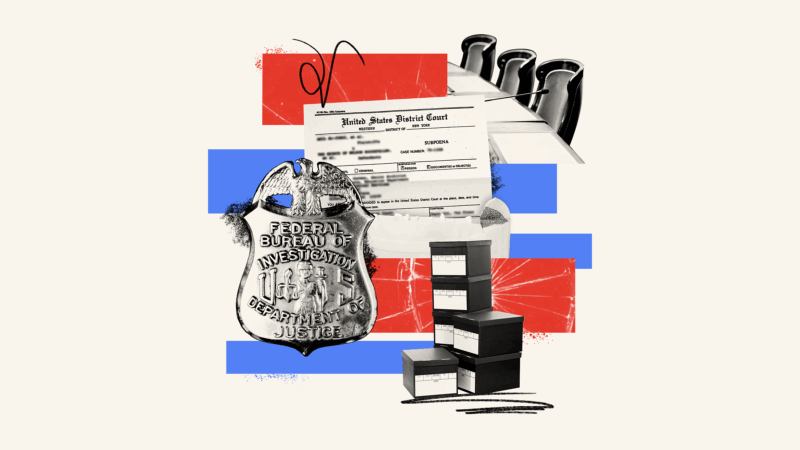Peaceful protest is a bulwark for democracy
- October 31, 2024
The importance of protecting space for peaceful protest in a period of rising authoritarianism

In the summer of 2023, a half a million people gathered in Warsaw to rally against Poland’s Law and Justice (PiS) party. The march was part of a series of organizing, protesting, and assembling, which ultimately saved Polish democracy after 8 years of autocratic rule.
This story looks quite different in Venezuela where, last month, small groups of just a handful of opposition supporters gathered at rallies — inside and outside the country — to protest autocratic President Nicolás Maduro’s corruption of the recent election. According to Voice of America, after dozens were arrested and “more than 2,400 other Venezuelans accused of terrorism for allegedly taking part in protests,” the opposition leader “called for smaller gatherings to avoid security crackdowns seen at earlier protests.”
As that contrast suggests, the right to peaceably protest and express dissenting views regarding government policies and political decisions is an essential ingredient of a functional democracy.
As the U.S. stands on the precipice of an election that may usher an authoritarian back into the White House, the health of our democracy may depend on whether we protect civic space for peaceful protest. Indeed, space for dissent can all too easily disappear unless supporters of democracy commit to protecting space for peaceful protest against government coercion, not just when doing so is easy but also when it’s hard.
Why protest matters in a democracy
Protest movements can be a critical political tactic to protect and improve a democracy — particularly for historically marginalized communities or groups lacking political power.
When other channels of democratic engagement feel closed off or fruitless, people can take to the streets to change policy or bring attention to an issue or movement. That’s been the case here in the U.S., where our political tradition has invited a broad range of political protest, from the Tea Party (both the one in Boston and the more recent iterations) to the Civil Rights era to, among recent examples, protests against COVID-era restrictions, or the Gaza anti-war protests. And with more and more of the public feeling like our political system doesn’t fully represent them, the availability of protest becomes all the more important.
Research and analysis around the world emphasize that creating open space for political expression is a core pillar of a democratic society. Nearly every contemporary metric of democratic health recognizes the importance of political expression, including the Freedom House Index, the Economist Intelligence Unit’s Democracy Index, and the V-Dem Index.
But protest can also be painful
And yet, notwithstanding its democratic virtues, peaceful protest can be painful or even offensive.
Protest can disrupt the routines of everyday life (like the lunch counter sit-ins of the civil rights protest movement); lay claim to public spaces, forcing itself to be seen by those who would prefer to avoid it (for example, Seattle protesters trying to create an “autonomous zone” amidst the Black Lives Matter protests); inflict emotional pain on historically vulnerable communities (like the Westboro Baptist Church anti-gay picketing at military funerals); socialize conspiracy theories (for example around public health); or lead to strong emotional discomfort (consider Lebanese women dressing as brides in bloody white wedding dresses to protest a rape law; or a Columbia student carrying a mattress everyday, including to her graduation, to protest the school’s sexual assault procedures).
That disruption is not accidental.
Peaceful protest is often designed to push limits — either to open space for negotiation, compromise, and change. Or it’s to prompt strong counter-reactions, creating empathy and attracting attention to the cause of the protesters. The Civil Rights era protests demonstrated both of these features. It’s no surprise, then, that recent U.S. protest movements, from BLM to protests against COVID restrictions to Gaza protests have caused varying degrees of discomfort and disruption. Even fully peaceful protests can prompt strong reactions, whether due to the substantive content of the particular protest (who is protesting and what their message is) or the tactics involved (such as large gatherings, filling or occupying public spaces, or being loud).
Balancing protections and the role of protest in democracy
How a healthy democracy navigates protest activity can, however, turn on whether the tactics employed are lawful or not. Despite protesters’ ability to engender strong reactions, a vibrant democracy should not be in the business of restricting peaceful, law-abiding protest activity simply because authorities disagree with its substantive content.
In fact, a vibrant democracy ensures that space is available for protest to take place.
At the same time, a functioning democracy is not without recourse when protest activity violates the law. Thus, while practitioners of civil disobedience have long recognized — to quote Martin Luther King Jr. — that when protesters do “break[] the law that conscience tells [them] is unjust,” they “must do it with a willingness to accept the penalty.” Public officials, for their part, typically have a number of lawful tools available to balance public safety and enforcement of the law with the rights of protesters. For example, U.S. courts have long recognized that the government may set content-neutral rules around the time, place, and manner of protest activity, and enforce those rules against protesters who violate them. So too, governments following legal process can of course punish protests that involve violence or incitement of imminent violence. Yet even when protest activities violate the law, a healthy democracy will address civil disobedience without resorting to disproportionate force.
Moreover it is not an uncommon occurrence that a small number of participants in a largely peaceful and law-abiding protest (perhaps rogue actors or false flag provocateurs) may violate the law in some form. In these situations, authorities can enforce the law and hold accountable those specific actors without quashing the protest as a whole.
When civic space in a democracy is open and functioning well, this can lead to a virtuous cycle: those with views on the other side of a protest can disagree with the substance of the message; critique the tactics of the protesters; and plan their own counter-protests. That can lead to reforms taking into account a range of views within a democracy.
As examples, in Japan, a social movement targeted the country’s third largest bank — using protests, ad campaigns, and even a shareholder resolution using the publicly-traded company’s procedures — and secured a commitment from the company to end financing of new coal power projects and end all loans for coal by 2050. Or in Namibia, the killing of a 22-year-old woman sparked a social media and protest movement that ultimately led to a meeting between protest leaders and the president and a promise to implement measures against offenders and dedicated courts to handle sexual and gender-based violence.
This is what a healthy liberal democracy looks like.
Beware the closing of civic space — even by good-faith actors
Unfortunately, however, because protest can be painful or offensive, prompt strong reactions, and threaten the status quo political power, it can be all too easy for government officials and others in positions of authority to seek to stifle or close off space for even peaceful protest. Even democratically minded public figures may sometimes overreact out of fear, under pressure, or through erring in an attempt to account for differing considerations.
As a result, even the well-intentioned use of government power to stifle peaceful protest undermines our democracy and makes it more vulnerable to aspiring autocrats. That’s because aspiring autocrats will take advantage of any precedent they can find for shutting down protest or responding with violence.
After all, the authoritarian playbook almost invariably includes efforts to quash dissent. In the same way that 21st century autocrats come to power through the ballot, not the bullet, closing civic space doesn’t always look like tanks in Tiananmen Square or beatings from Bull Connor.
We’ve seen actions from a range of different actors across the U.S. political spectrum that all curtail space for protest:
- Some come in the form of legislation, like new laws in Oklahoma and Florida that immunize drivers who hit protesters or in Louisiana, where a law lowers the bar to holding organizers liable for the actions of any who attend a protest; others are policy approaches from government agencies, like California’s attempt to ban COVID protests.
- Other attempts to curtail space involve the aggressive use — or threat — of law enforcement, like that taken by DHS officials against protesting moms in Portland or state troopers aiming sniper weapons at student protesters at Indiana and Ohio State University, calls from Senators to deploy the National Guard to quash campus protests, or threats from a presidential candidate to invoke the Insurrection Act against those protesting his administration.
- In other situations it involves indirect pressure from government officials, for example when Members of Congress threaten college presidents with funding cuts to colleges that have not met Members’ preferred approach to balancing First Amendment protest rights with anti-discrimination provisions, even threatening to strip accreditation of universities. (Some forms of indirect government pressure—such as “behind closed doors” convenings by government agencies with private actors like college administrators—can be especially pernicious because of their ability to close civic space without being detected.)
- Another variation involves government officials incentivizing private actors to target protests; for example, the Governor of Texas pardoned a man convicted of shooting a Black Lives Matter protester, sending the signal that this type of conduct is acceptable.
Each of these examples involves different government actors (some legislators, some executive, some federal, some state, some local); different mechanisms for reducing protest space; and in response to protests by different actors on different substantive topics. But what they share is that they make it more difficult, more dangerous, and more risky to assemble in protest, even peacefully. And these types of protest-quashing policies and actions are also distinct from constitutional practices like content-neutral time, place and manner rules or enforcing the law against violent actions that protect important public interests while leaving open space for protest.
Brace for protests — and protect them when they’re peaceful
We’re at a pivotal moment in U.S. democracy. And in this moment, we can expect a range of protest activities, such as protest around the outcome of the election; a continuation of protest activity on campuses around the country; and with the possibility of an autocrat in the White House come January, the civil disobedience that would likely spur.
In these times, we should start from the premise that however tempting or well-meaning it may be to curtail a peaceful protest on a particular topic in a particular place for a particular reason using a particular tactic, these abridgements over time and across topics add up to an infringement on our democracy.
Those of us across the political spectrum who are worried about the authoritarian threat to U.S. democracy should put a thumb on the scale of creating more space for protest. We should tread carefully in using our authority or influence to limit space for peaceful protests. We should stand together against coercive uses of state power to abridge civic space for peaceful assembly and protest. And we should look to do so not just when we are sympathetic to the protesters, but especially when the message of those protests challenges us and our perspectives.
Protest can be painful. It can be offensive. It can be outrageous. It can be disruptive. But we will want the ability to turn to it when we need it — and if we lose it, we’ll miss it when it’s gone.
This piece was originally published on If You Can Keep It
Related Content
Join Us.
Building a stronger, more resilient democracy is possible, but we can’t do it alone. Become part of the fight today.
Donate
Sign Up for Updates Sign Up for Updates
Explore Careers Explore Careers
How to Protect Democracy How to Protect Democracy

